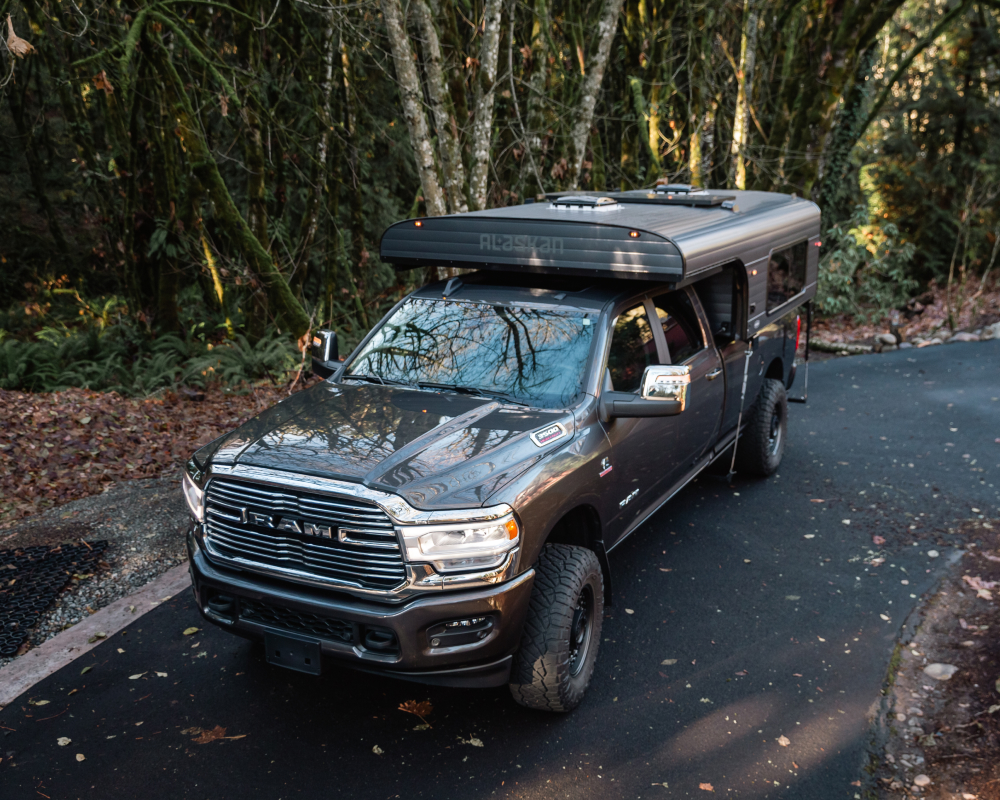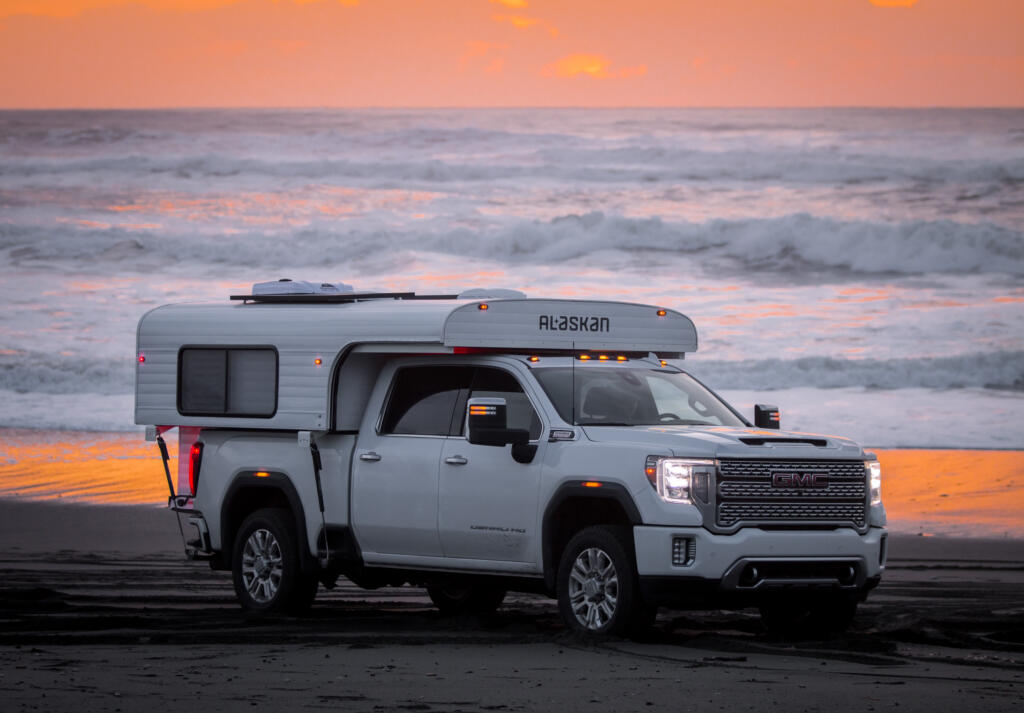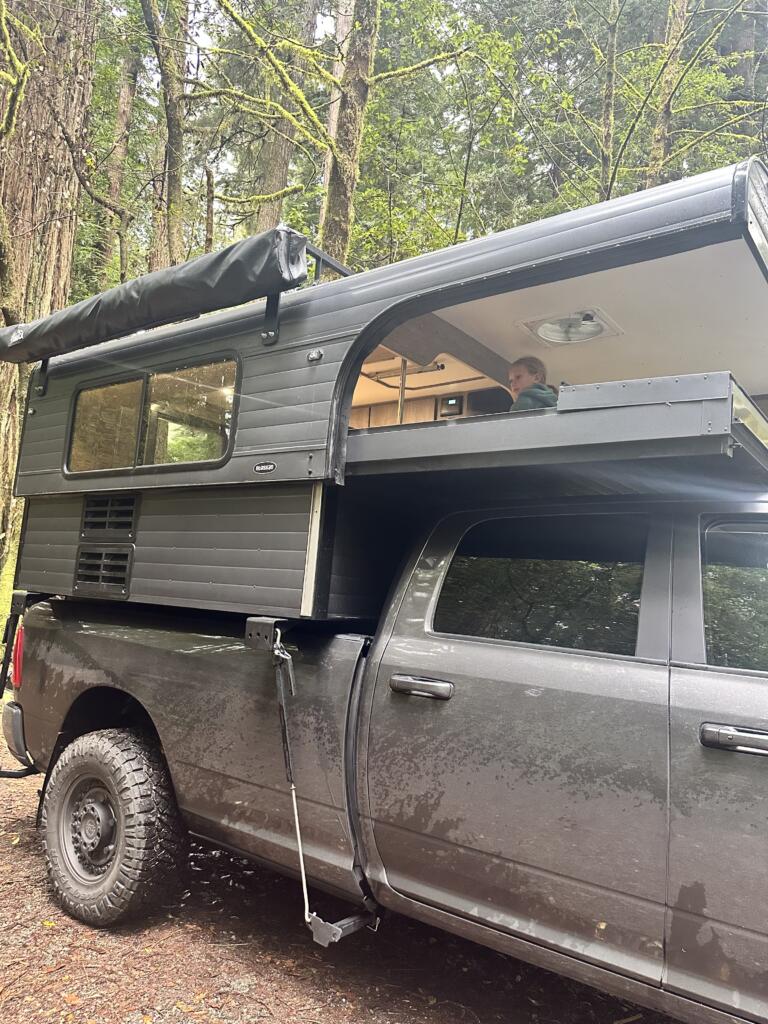The Right Truck Size for an Alaskan Camper
We Recommend a Full-Size, 3/4-Ton (or Larger) Truck
Let’s cut to the chase and save you some time here—you’re going to want a pretty large rig. Alaskan Campers are built to last and handcrafted from quality materials and can range in (dry) weight from 1,700 – 2,400 lbs. For the best performance and safety, we recommend at least a full-size, 3/4 ton truck. Truck classifications like half-ton, 3/4-ton, and 1-ton, refer to payload capacities. For context, within Ford’s lineup: the F-150 is a half-ton, the F-250 a 3/4-ton, and the F-350 a 1-ton. To be transparent, we’ve equipped 1/2-ton rigs before but we would need to discuss truck specs and the camper you’re targeting before we promise anything. Give us a call, though, we’re happy to chat through everything.

A Payload Refresher
Understanding the payload rating of a truck is crucial when it comes to hauling an Alaskan Camper. To determine your vehicle’s maximum payload capacity, subtract the curb weight from the Gross Vehicle Weight Rating (GVWR) The GVWR is usually located on a sticker inside the driver’s side door jam or easily found online. For instance, if your truck weighs 5,000 pounds and the GVWR is 7,500 pounds, the maximum payload is 2,500 pounds. This figure includes the total weight of passengers and cargo within the vehicle. Overloading your truck beyond the payload and GVWR is unsafe for everyone on the road and can lead to significant damage to the truck’s frame, suspension, and tires, potentially voiding any warranties and compromising vehicle integrity.
Modern Payload Capacities
Gone are the days when the terms half-ton, three-quarter-ton, and one-ton directly corresponded to the actual payload capacities of trucks. Today’s vehicles far exceed those traditional classifications. For instance, the specs on a Ram 3500 SRW 4WD short-bed truck revealed a staggering payload capacity of 3,358 pounds. Similarly, modern three-quarter-ton trucks can handle payloads as hefty as 4,300 pounds, and one-ton Duallys can get up to 7,800 pounds! Even today’s half-ton trucks, such as the 2023 Ford F-150 with a 5.0-liter V8, can have payload capacities ranging from about 1,000 to over 2,000 pounds, with some models capable of handling up to 3,310 pounds. That all being said, while we tend to recommend 3/4-ton and larger for the best performance, an Alaskan Camper can be safely secured to a 1/2-ton pickup, it just depends on the truck and the camper’s size. Again, just let us know and we can talk through all the details.
Payload Capacity vs. Towing Capacity
Payload capacity refers to how much weight a vehicle can safely carry within itself—essentially, the total weight you can load into the truck’s bed or cabin. Remember to include passengers in your payload calculations—if you have five 200-pound individuals in the vehicle, that adds up to 1,000 pounds of payload! On the other hand, towing capacity is the amount of weight a vehicle can pull behind it, such as a trailer. Automakers often use the term ‘hauling’ to describe carrying weight in a vehicle’s bed to differentiate it from towing. Though towing capacity typically exceeds payload capacity, it’s important to remember that payload capacity still influences towing, much like how carrying a heavy backpack would affect your ability to pull additional weight.

Wet vs Dry Weight
The “wet weight” for Alaskan Campers refers to the total weight of the camper when it is fully equipped and ready for travel, including all consumables, fluids, and installed accessories. This encompasses the total weight of fresh water, propane, and batteries, plus any additional gear or supplies you might carry. Essentially, it’s the camper’s weight fully prepared for a trip, including all items that contribute to the weight beyond its empty or “dry” state. Keep in mind that the final wet weight of your Alaskan Camper will vary depending on your specific configuration. We tailor each camper to individual wishlists, so the dry weight range of 1,700 – 2,400 lbs. represents an average from our fully outfitted models
Bed Length
Alaskan Campers are available in various sizes, including 6.5 ft, 7 ft, 8 ft, 8.5 ft, and 10 ft models, accommodating virtually any truck bed length. The size you choose ultimately depends on your personal preference for space and the demands of your travels. Whether you need a compact model for tighter trails or a larger camper for extended comfort, there’s an Alaskan Camper perfectly tailored to enhance your travel experience. As a note, we’ve noticed modern truck beds have been shrinking the past decade so we’ve adapted by fine-tuning our 6.5 ft models to better suit beds that are often just 6’3” in length—which can influence whether tailgates are closed or removed.
Tie Down Compatibility
Alaskan Campers partners with Torklift International to ensure every truck is mounted safely and securely. Unlike other tie-down systems that often attach to the weaker parts of a truck, TRUE Frame-Mounted Camper Tie Downs from Torklift connects directly to the truck’s frame—the strongest part of the vehicle. Because bed-mounted systems attach to the thin sheet metal of the truck bed, they often cause flexing, cracking, and exterior rust due to the stress placed on this weaker material. By anchoring your camper directly to the truck frame, you attach it to the strongest and safest part of your vehicle. This is essential for managing the camper’s weight and movement, which helps prevent load shifting and maintains the vehicle’s center of gravity, ensuring safer handling under all conditions.

“Will My Existing Truck Fit an Alaskan Camper?”
So, you read this and thought “But I already own a rig—I’m pretty sure it’ll work just fine” — that’s not a problem. Jot down your truck specs and payload and give us a call. We’re here to assist you in evaluating your truck’s capability to handle the demands of an Alaskan Camper and also determine which model would be ideal for your rig and travel goals.
